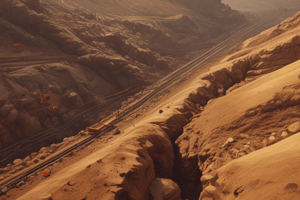Podcast
Questions and Answers
Which geotechnical project involves shallow foundations?
Which geotechnical project involves shallow foundations?
- Shallow foundations (correct)
- Deep foundations
- Dams
- Retaining walls
What concerns geotechnical engineers?
What concerns geotechnical engineers?
- Data accuracy
- Safety
- Performance
- All of the above (correct)
What are the two types of foundations mentioned?
What are the two types of foundations mentioned?
Shallow and Deep foundations
What is the tallest freestanding structure in the world?
What is the tallest freestanding structure in the world?
What caused the failure of the Kissing Buildings in Nigatta, Japan?
What caused the failure of the Kissing Buildings in Nigatta, Japan?
Geotechnical engineering requires an adequate estimation of the engineering properties of the _______.
Geotechnical engineering requires an adequate estimation of the engineering properties of the _______.
What testing methods are used in geotechnical engineering?
What testing methods are used in geotechnical engineering?
The Burj Khalifa is the tallest building in the world.
The Burj Khalifa is the tallest building in the world.
Which of the following is a type of foundation in geotechnical engineering?
Which of the following is a type of foundation in geotechnical engineering?
What is a primary concern of geotechnical engineers?
What is a primary concern of geotechnical engineers?
The Burj Khalifa is the tallest building in the world.
The Burj Khalifa is the tallest building in the world.
What major event occurred in Nigatta, Japan in 1964?
What major event occurred in Nigatta, Japan in 1964?
The Leaning Tower of Pisa has become a _______.
The Leaning Tower of Pisa has become a _______.
What is the function of site studies in geotechnical engineering?
What is the function of site studies in geotechnical engineering?
Which of these is a method used in laboratory testing for geotechnical engineering?
Which of these is a method used in laboratory testing for geotechnical engineering?
What is necessary for a good geotechnical design?
What is necessary for a good geotechnical design?
Flashcards are hidden until you start studying
Study Notes
Geotechnical Engineering Overview
- Geotechnical projects encompass a variety of structures including shallow and deep foundations, retaining walls, slope stability, dams, offshore foundations, and tower foundations.
- Toronto's CN Tower holds the record for the world's tallest freestanding structure at 553 m.
- Burj Khalifa in Dubai is the tallest building globally, standing at 828 m.
Geotechnical Engineer Concerns
- Essential considerations include data accuracy, safety, performance, economy, convenience, effectiveness, environment, and sustainability.
- Important questions for engineers involve ground characterization, design parameter estimation, design convenience, safety assurance, cost-performance optimization, effective construction, and environmental impact assessment.
Key Design Requirements
- A thorough design necessitates:
- Accurate estimation of engineering properties of ground strata.
- Comprehensive understanding of geotechnical work behavior.
- Knowledge of key parameters influencing that behavior.
- Experience and expertise in geotechnics to prevent catastrophic outcomes.
Historical Failures
- Notable failures include:
- The Kissing Buildings in Nigatta, Japan (1964) collapsed due to stress concentration and insufficient bearing capacity.
- Leaning Tower of Pisa, a monument due to its unintended tilt.
- A building in Minxing District, Shanghai, toppled during construction (June 2009) due to inadequate foundation support.
Methodological Approach
- Key approaches in geotechnical design include:
- Site Studies: Involves sampling and field testing to gather data on soil properties.
- Laboratory Testing: Assesses soil behavior under loading through tests like shear box and triaxial cell.
- Office Design: Utilizes collected data to design safe structures.
- Construction Monitoring: Ensures alignment with design specifications, adapting to any unexpected soil characteristics.
Testing Techniques
- Various testing methods employed include:
- Shear Box: For measuring soil shear strength.
- Oedometer: For evaluating soil consolidation and compressibility.
- Triaxial Cell: Allows determination of soil strength and stress-strain behavior under controlled conditions.
Geotechnical Engineering Overview
- Geotechnical projects encompass a variety of structures including shallow and deep foundations, retaining walls, slope stability, dams, offshore foundations, and tower foundations.
- Toronto's CN Tower holds the record for the world's tallest freestanding structure at 553 m.
- Burj Khalifa in Dubai is the tallest building globally, standing at 828 m.
Geotechnical Engineer Concerns
- Essential considerations include data accuracy, safety, performance, economy, convenience, effectiveness, environment, and sustainability.
- Important questions for engineers involve ground characterization, design parameter estimation, design convenience, safety assurance, cost-performance optimization, effective construction, and environmental impact assessment.
Key Design Requirements
- A thorough design necessitates:
- Accurate estimation of engineering properties of ground strata.
- Comprehensive understanding of geotechnical work behavior.
- Knowledge of key parameters influencing that behavior.
- Experience and expertise in geotechnics to prevent catastrophic outcomes.
Historical Failures
- Notable failures include:
- The Kissing Buildings in Nigatta, Japan (1964) collapsed due to stress concentration and insufficient bearing capacity.
- Leaning Tower of Pisa, a monument due to its unintended tilt.
- A building in Minxing District, Shanghai, toppled during construction (June 2009) due to inadequate foundation support.
Methodological Approach
- Key approaches in geotechnical design include:
- Site Studies: Involves sampling and field testing to gather data on soil properties.
- Laboratory Testing: Assesses soil behavior under loading through tests like shear box and triaxial cell.
- Office Design: Utilizes collected data to design safe structures.
- Construction Monitoring: Ensures alignment with design specifications, adapting to any unexpected soil characteristics.
Testing Techniques
- Various testing methods employed include:
- Shear Box: For measuring soil shear strength.
- Oedometer: For evaluating soil consolidation and compressibility.
- Triaxial Cell: Allows determination of soil strength and stress-strain behavior under controlled conditions.
Studying That Suits You
Use AI to generate personalized quizzes and flashcards to suit your learning preferences.




